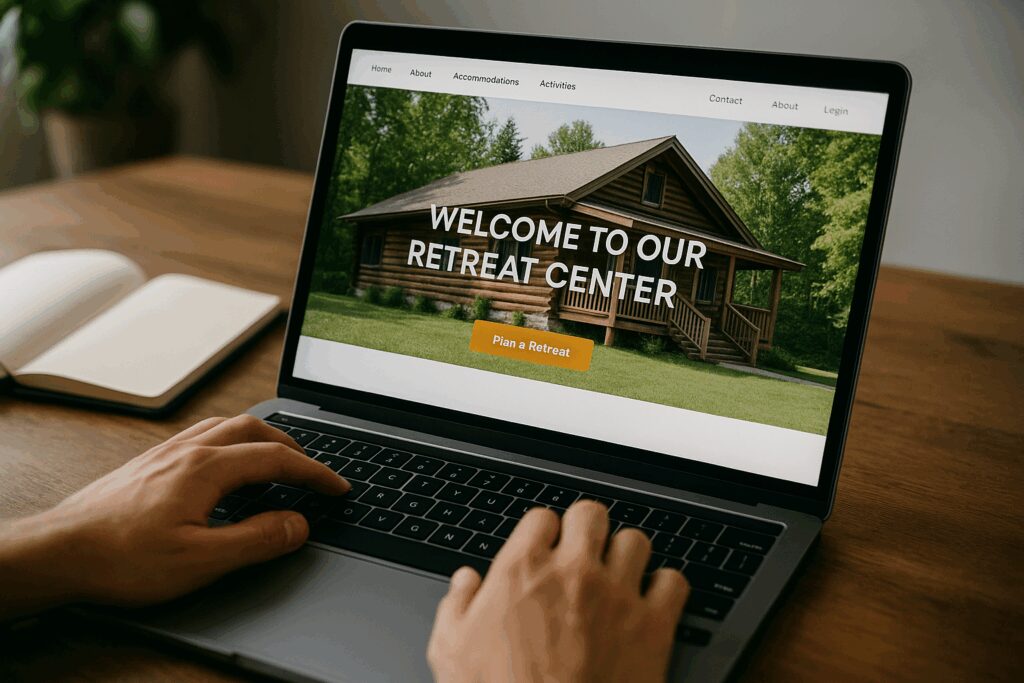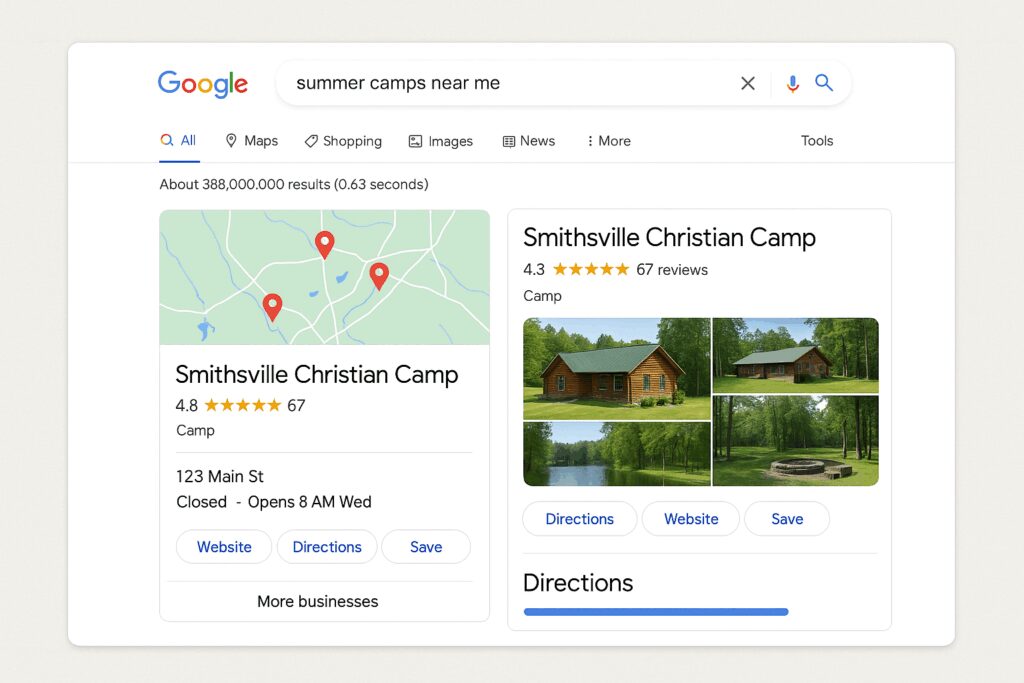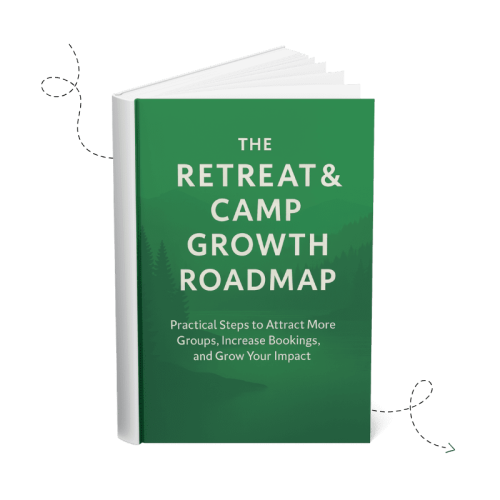Retreat & Camp Growth Roadmap Stage 1: Establish Your Foundation
Introduction
Before you can grow retreat bookings or run successful camp marketing campaigns, you need a solid foundation. Stage 1 of the Retreat & Camp Growth Roadmap is where that groundwork begins.
In this article, we’ll walk through the three essential steps in Stage 1 for establishing a strong foundation for your organization’s marketing efforts—Define Your Strategy, Build Your Platform, and Establish Your Presence. Each section includes links to deeper guides for further learning. Whether you’re just starting or trying to fix an inconsistent flow of inquiries, this stage gives you the structure to attract and convert mission-aligned groups more effectively.
Why This Focus Area Matters
Many retreat centers and camps jump right into marketing—ads, content, or outreach—without first clarifying their message or setting up systems to manage new inquiries. As a result, they may waste time, miss opportunities, and struggle to convert the interest they do receive.
Stage 1 is about stewardship: investing your time and resources wisely by building a framework that supports long-term growth. A clear strategy, a functional website, and strong local visibility help you not only attract the right groups but also build trust and convert inquiries into bookings. Done well, these foundational steps increase impact and reduce wasted effort.
Is This an Area You Need to Focus on Right Now?
Ask yourself:
- Are at least 30% of your bookings coming from your marketing efforts?
- Do you have a hard time explaining who you serve or what makes your organization unique?
- Does your website generate inquiries consistently—or at all?
- Can new guests find you when they search online?
- Are leads falling through the cracks because there’s no follow-up system?
- Are you able to answer the above questions with actual facts and statistics?
If you answered “no” to any of these, this focus area can help you bring greater clarity, alignment, and impact to your outreach.
Define Your Strategy
Before you can effectively promote your retreat center, you need to establish a clear strategic foundation. This step focuses on identifying your ideal audience, clarifying your message, and defining how you’ll handle leads. For a full walkthrough of this step, including practical tips and common pitfalls, check out the in-depth article linked below.
👉 Read the full article on Step 1 – Define Your Strategy
Clearly defining your strategy will give you the clarity and consistency needed to begin marketing with confidence. What follows is an overview of each of the three focus areas within this step, along with links to in-depth articles that explore each one in more detail.
Identify Your Audience
Many retreat centers offer a wide range of experiences, but that doesn’t mean your marketing should speak to everyone at once. Clarifying your core audiences—like youth groups, leadership retreats, or women’s ministries—helps you tailor messaging that connects.
👉 Read: The Surprising Power of Clarifying Exactly Who Your Retreat or Camp Serves
Getting clear on your audience not only shapes your messaging, it informs the systems and tools you’ll need to support meaningful outreach. With your audience defined, it’s time to move into the next critical element of strategy: crafting messaging that speaks directly to their needs and reflects your mission clearly.
Craft Brand Messaging
Once you know who you’re speaking to, your messaging should reflect their goals and concerns. A compelling message invites the right groups to engage and clearly communicates your mission and value.
👉 Read: How to Craft Brand Messaging That Attracts Mission-Aligned Groups
Clear, compelling messaging turns interest into engagement. With your message refined, the next step is making sure your team is prepared to respond consistently and effectively when someone reaches out.
Improve Lead Handling
When someone reaches out, what happens next? Defining a consistent lead handling process—whether it’s an email reply, call scheduling, or CRM automation—helps you respond faster and book more groups.
👉 Read: Retreat & Camp Lead Handling: How to Stop Losing Inquiries Before You Ever Talk to Them
Having a lead handling process in place ensures no inquiry gets missed and every potential guest is served with care and consistency. Together, the three focus areas in this step create a unified strategy that brings clarity, consistency, and intentionality to your marketing efforts. Now that your strategy is defined, it’s time to build the platform and systems that will help you carry it out effectively.

Build Your Platform
Your website and lead management tools are more than a digital brochure—they’re your frontline for ministry communication. In this step, you build the tools that support your strategy and allow you to track and manage new inquiries. For a full walkthrough of this step, including practical tips and common pitfalls, check out the in-depth article linked below.
👉 Read the full article on Step 2 – Build Your Platform
Clearly building your platform gives your strategy a place to thrive, ensuring your messaging and processes are carried out with clarity and efficiency. What follows is an overview of each of the three focus areas within this step, along with links to in-depth articles that explore each one in more detail.
Launch Lead-Ready Website
Your website should do three things: build trust, clearly communicate your offerings, and make it easy to inquire. Many retreat centers miss opportunities by making users dig for info or by using outdated designs.
👉 Read: How to Launch a Lead‑Ready Website That Builds Trust and Drives Retreat Inquiries
A lead-ready website gives your messaging a home and turns interest into inquiry. With this foundation in place, it’s time to make sure those inquiries are managed well.
Setup Lead Management
A good CRM (Customer Relationship Management tool) helps you collect, organize, and follow up with leads efficiently. It’s not about complexity—it’s about making sure no inquiry goes unanswered.
With lead management in place, you ensure every inquiry receives a timely and meaningful response. But collecting and managing leads is only part of the equation—next, you need to know what’s working and what’s not.
Configure Tracking & Analytics
Data doesn’t have to be overwhelming. Setting up basic tracking (like Google Analytics and lead source tracking) helps you make better decisions about where to invest your marketing efforts.
👉 Read: Track What Matters: A Retreat Center Guide to Smarter Analytics and Ministry Decisions
With your analytics in place, you now have a platform that empowers informed decision-making and consistent lead conversion. These tools ensure your team is equipped to act on the clarity established in Step 1. Next, we’ll look at how to estaslish your online presence so that you are easily found by your target audience when they are searching for a retreat center or camp.

Establish Your Presence
Even the best website won’t help if people can’t find it. Step 3 is about increasing visibility so new guests discover you online. For a full walkthrough of this step, including practical tips and common pitfalls, check out the in-depth article linked below.
👉 Read the full article on Step 3 – Establish Your Presence
Clearly establishing your presence ensures that your platform doesn’t just sit idle—it actively draws in the right people at the right time. What follows is an overview of each of the three focus areas within this step, along with links to in-depth articles that explore each one in more detail.
Enhance Google Listing
Claiming and optimizing your Google Business Profile ensures you show up on maps and search results when planners search for retreats in your area.
👉 Read: Stand Out on Google Maps: How Retreat Centers & Camps Turn Searches into Bookings
A strong Google listing not only increases your visibility, it builds instant credibility with prospective guests. Once that’s in place, it’s time to extend your reach even further by showing up in more of the directories that your ideal guests rely on.
Expand Directory Listings
There are dozens of free or low-cost directories where your retreat center can appear—from Christian directories to event platforms. The goal is to meet planners where they already look.
👉 Read: Get Found in More Places: Directory Listing Strategies for Retreat Centers & Camps
Directory listings multiply your visibility and create more entry points for prospective guests to discover your ministry. Once your listings are in place, the next step is to boost your visibility through search engines with local SEO.
Start Local SEO
Local SEO (Search Engine Optimization) involves optimizing your site and listings to show up in local searches. It’s one of the most effective and affordable ways to attract new inquiries.
Strong local SEO ensures that the people searching for retreats in your region can actually find you—and feel confident choosing you. Together, these three focus areas establish a presence that helps you get discovered, build credibility, and guide more people to take the next step with you.

Mini Case Study
Black Rock Christian Camp & Retreat Center is a well-established ministry in Pennsylvania. Like many retreat centers, they had a strong program and loyal guests—but they lacked the digital foundation to reach new audiences consistently.
They began by clarifying their core offerings and ideal group types. From there, they overhauled their website to improve navigation and include clearer calls to action. They also implemented a CRM to manage inquiries and set up analytics to measure performance.
These foundational changes led to more than just a better website—they created a system that consistently brought in new, mission-aligned leads. Over time, they saw significant growth in bookings and a stronger year-round calendar.
Black Rock’s success shows what’s possible when you align your strategy, tools, and message from the ground up. Read the full case study.
Putting It All Together
Establishing your foundation isn’t flashy, but it’s critical for successful retreat center marketing and sustainable growth. Without clarity, consistency, and the right tools, you risk spinning your wheels and missing your mission.
Here are key takeaways from Stage 1:
- Get clear on who you serve and what you offer.
- Craft messaging that connects with your core audience.
- Set up a website that converts, not just informs.
- Put a lead management process in place so no inquiry gets lost.
- Claim and optimize your online listings to increase visibility.
Once your foundation is in place, you’re ready to begin generating consistent inquiries with confidence. This sets the stage for future camp marketing strategies that drive momentum and long-term results.
Ready to Take the Next Step?
Laying the groundwork through Stage 1 is essential for effective retreat and camp marketing. With a clear message, reliable systems, and online visibility, you’re equipped to reach more people and fulfill your mission with confidence.
You’ve laid the foundation—now it’s time to build momentum by attracting more qualified inquiries.
If you found this helpful, here are four great next steps to continue your journey:
🧭 Move to the Next Stage: Build Your Momentum
Learn how to build the marketing system to drive consistent group inquiries and turn them into bookings.
[Read the Build Your Momentum Stage Article]
📘 Download the Retreat & Camp Growth Roadmap eBook
Get the full 3-stage system we use to help retreat centers and camps grow with clarity and purpose.
[Download the eBook]
🌱 Learn More About How We Help Retreat Centers & Camps
We’re a Christian-owned digital marketing agency that helps retreat centers and camps grow attendance, bookings, and impact through practical strategies rooted in clarity and stewardship.
[See How We Can Help]
🤝 Schedule a Free Discovery Call
Want help applying this to your unique situation? Let’s talk. We’ll explore where you are now, where you want to go, and how to take the next faithful step.
[Book a Discovery Call]
You don’t have to figure this out alone. Let’s build something meaningful—together.
Frequently Asked Questions
What’s the most important part of Stage 1?
While each step in Stage 1 is valuable, clarity in messaging and audience targeting often delivers the fastest and most significant improvements. When you know exactly who you’re trying to reach and how to speak to their needs, your efforts become more focused and effective. It sets the stage for everything else—from website design to lead follow-up.
Do I need a CRM even if we don’t get a lot of inquiries?
Yes, you do. A CRM helps you track every inquiry, maintain a history of communications, and follow up reliably—critical habits for growing bookings over time. Even if you’re only managing a handful of leads each month, a CRM prevents missed opportunities and shows you what’s working.
How do I know if my website is “lead-ready”?
A lead-ready website doesn’t just inform—it invites action. It clearly communicates who you serve and what you offer, includes trust-building content like photos and testimonials, and makes it easy to inquire or get in touch. If visitors are leaving without taking action, it may be time to revisit your design and messaging.
Is Local SEO really worth it for a small camp or retreat center?
Absolutely. Most group planners begin their search online, using terms like “retreat centers near me.” If your website and Google listing aren’t optimized for local search, you’re likely invisible to those actively looking for a place like yours. Local SEO is one of the most cost-effective ways to increase visibility and inquiries for retreat centers and camps, particularly if you are operating on a small budget.
How much does it cost to be listed in directories?
Many high-quality directories are free or offer free listings with basic information. Some do offer premium placements for a fee, which can be worthwhile if they attract your ideal audience. The key is to focus on relevance over quantity—being in the right places matters more than being everywhere.
We already have a good reputation—why do we need this?
A good reputation is an asset, but it only helps if people can find you and understand why you’re a great fit for them. Stage 1 turns your reputation into results by clarifying your message, making you more discoverable, and ensuring leads are handled professionally.
What kind of messaging should we avoid?
Avoid vague or generic language that could apply to any retreat center. Phrases like “a place for everyone” or “peaceful and relaxing” don’t tell people what makes you unique. Instead, highlight the specific benefits you offer to your ideal audiences and connect with their goals or values.
Can I do all of Stage 1 myself?
Yes, many leaders do start Stage 1 on their own. If you’re willing to invest time into learning and applying the steps, you can make significant progress. That said, bringing in a knowledgeable partner can help you avoid common pitfalls and implement your strategy more efficiently.
How long does it take to see results from this stage?
The timeline depends on your starting point and the resources you can commit. Updating messaging or fixing website issues can yield results quickly. Improvements from SEO and directories usually take a few months, but they build lasting momentum once in place.
Do I need to finish Stage 1 before moving on to Stage 2?
Yes. If your strategy, messaging, or systems aren’t solid, any marketing you do in Stage 2 will likely underperform. Completing Stage 1 ensures you’re not wasting time and money on campaigns that can’t convert. It’s a wise investment that pays off long-term.





